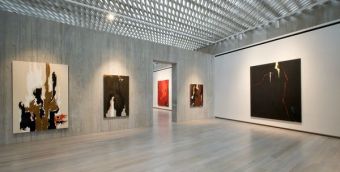
Clyfford Still Museum interior (at right, "1944-N #1," oil on canvas, 8 1/2' by 7 1/2'), ‘Still’s breakthrough came in 1943-44, when he made the first Abstract Expressionist painting. The selection shows where that monumental work, "1944-N #1," came from..’.
On recent reading of Susan Landauer’s mesmerising “The San Francisco School of Abstract Expressionism,” (published in 1996, University of California Press) it is clear that in America, Abstraction was inherently a national phenomenon as opposed to the common perception that it was centred on the East coast. In Landauer’s important focus on West Coast painters it is evident that their innovative and intense output was no less than sublime. In light of the establishment of significant museums dedicated to individual painters, it would be interesting to provoke contemporary discussion on the breadth of Abstraction across continents, all be it a potentially (to coin Landauer’s word printed inside the dust jacket) ‘gritty’ subject. It is to this similar geographical reference and period that Christopher Knight, in the Los Angeles Times Art review, states that the ‘Denver’s Clyfford Still Museum is now its exclamation point’, to which one is unequivocally inclined to agree. Read more here.
The inaugural installation of Clyfford Still works, curated by Museum director Dean Sobel and adjunct curator David Anfam is further hailed as a ‘knock-out’. One can only wonder with awe as to what it must have been like to have removed the masking tape on so many of Still’s rolled up and previously unseen works and further admire the achievement that this magic is so evidently held throughout the installation.
David Anfam has aptly described Still’s work as considering a painting’s surface to be “hostile terrain”, evoking an interesting space for further discussion. Similarly the work in Landauer’s book, 16 years on, has bite, is beguiling, bold and brave. The alluring Clyfford Still Museum promises to capture and hold a critical history sharply in focus, located geographically in the centre and centrally in the present, all for which this contemporary painter is grateful.
Posted by Kristina Huxley
